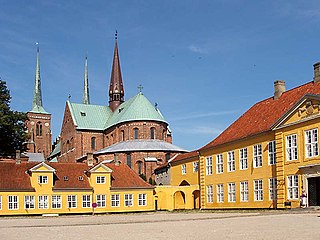
Roskilde, located 30 km (19 mi) west of Copenhagen on the Danish island of Zealand, is the main city in the eponymous municipality. With a population of 51,793, the city is a business and educational centre for the region and the 10th largest city in Denmark. It is governed by the administrative council of Roskilde Municipality.

Church frescos or church wall paintings are to be found in some 600 churches across Denmark, no doubt representing the highest concentration of surviving church murals anywhere in the world. Most of them date back to the Middle Ages and were uncovered by Jacob Kornerup (1825–1913) who carried out restoration work in 80 churches across the country towards the end of the 19th century. They lay hidden for centuries as after the reformation, they were covered with limewash only to be revealed and restored during the course of the 19th and 20th centuries. In most of Europe medieval frescos, extremely common in the Middle Ages, were more likely to be removed completely during the Reformation or in subsequent rebuildings, or merely as they aged. The oldest frescos, dating back to the 12th century, were painted in the Romanesque style by artists from elsewhere in Europe but those from the 14th century and thereafter are in the Gothic style which was used by native Danish painters. It is these that are considered to be the most important for Danish art and culture. A distinction is to be made between these church wall paintings or kalkmalerier and the generic term "fresco" which refers to all types of painting on plastered walls or ceilings.

Tuse Church is located near Holbæk in northwestern Sealand, Denmark. It dates back to the year 1200.
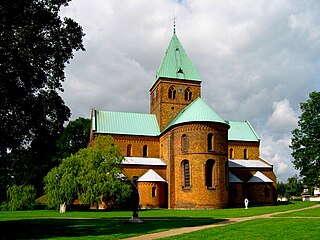
St. Bendt's Church is a church in Ringsted, Denmark, which was originally part of a Benedictine monastery that burnt down in the 18th century. Built in the Romanesque style, it is the oldest brick church in Scandinavia, dating back to about 1170 when it replaced a travertine church from about 1080. It is considered to be one of Denmark's architecturally finest churches. Furthermore, it is of special historical interest as it is first Royal church in Denmark and it houses the tombs of many of Denmark's earlier monarchs and noblemen.
Paul Briegel Høm was a Danish artist who is remembered for his religious paintings and brightly coloured stained glass windows which decorate a number of Danish churches.

St. Peter's Church is a Romanesque parish church some 6 km east of Aakirkeby on the Danish island of Bornholm. It is thought to be the oldest church on the island.
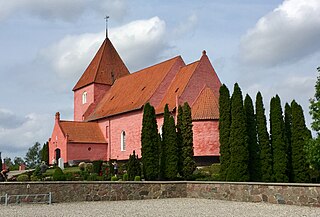
Tingsted Church, located on high ground in the village of Tingsted on the Danish island of Falster, dates from c. 1200. Built in the Romanesque style, it is best known for its frescos from the end of the 15th century.
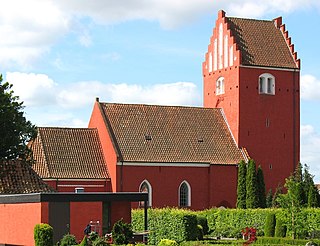
Nørre Alslev Church in the small town of Nørre Alslev in the north of Danish island of Falster dates from at least 1308, a date found on its early frescos. Built in the Early Gothic style and painted pink according to local tradition, it is best known for its fresco of the death dance.
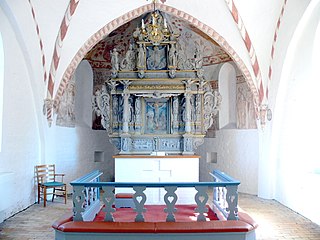
Jørgen Ringnis, also known as "Jørgen Billedsnider", was a Danish woodcarver. He created a number of altarpieces and pulpits in Danish churches, especially on the islands of Lolland and Falster.

Stubbekøbing Church is located in Stubbekøbing some 18 km (11 mi) northeast of Nørre Alslev on the Danish island of Falster. The basilical nave was built of limestone in the Late Romanesque period. Choir and tower are of brick, the choir built in Early Gothic style, tower and the northern chapels in the 15th century in Late Gothic style. In addition to its Renaissance altarpiece and pulpit, it has a variety of old frescos and wall decorations (1300–1500).

Abel Schrøder, also Abel Schrøder the Younger, was a Danish woodcarver with a workshop in Næstved, then the centre for woodcarving in Southern Zealand. He is remembered for his many auricular altarpieces and pulpits depicting scenes from the life of Christ. Schrøder was also the organist for 42 years in St Martin's Church, Næstved.

Hans Holst was a Danish woodcarver associated with Køge where he designed the pews and the pulpit in St Nicholas Church.

Undløse Church is located in the village of Undløse some 17 km (11 mi) southwest of Holbæk in northern Zealand, Denmark. The original part of the Romanesque church derives from the late 12th century. The church is noted for its early 15th-century frescoes and for its elaborate Baroque altarpiece and pulpit, both woodcuts by Abel Schrøder.

The Old Church of Our Lady is an 11th-century brick church in Roskilde on the Danish island of Zealand.

Saint Jørgensbjerg Church is a historic church in Roskilde on the Danish island of Zealand. With a nave and chancel in travertine limestone dating from c. 1080, it is Denmark's oldest preserved stone building.
Brix Michgell, also Brix Michael, was a carpenter and wood carver who was active in Roskilde on the Danish island of Zealand. He is remembered for his intricately carved pulpits and altarpieces in the area.

Saint Peter's Church is a Lutheran church located in the center of Slagelse, Denmark. The congregation was originally part of the Roman Catholic Church, but was converted to Lutheranism during the Reformation.





















